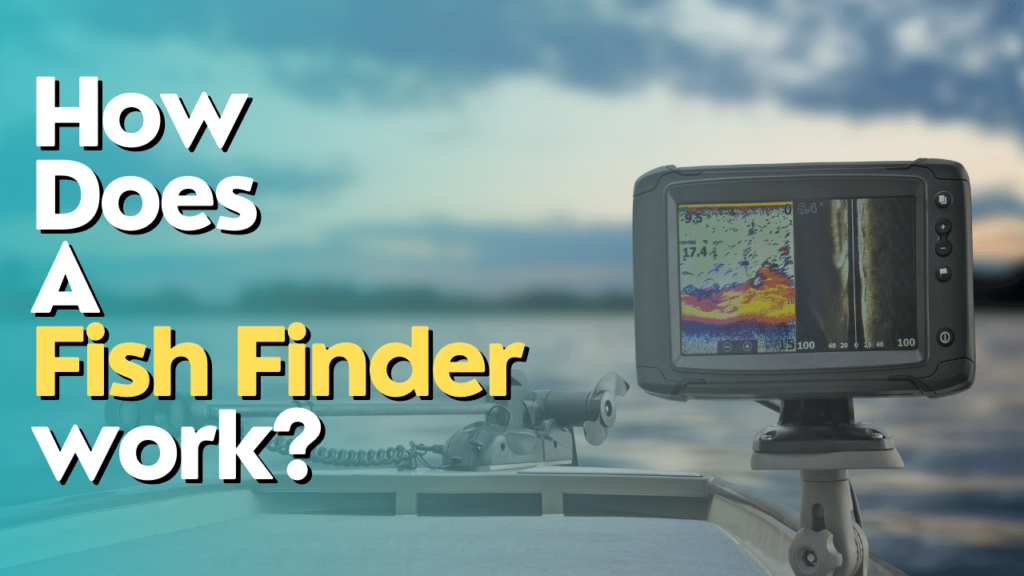
Fish finders are indispensable tools for anglers and fishermen, using sonar technology to locate fish. But how does a fish finder work?
In short, a fish finder operates by sending sound waves into the water. These waves spread out and reflect back when they encounter objects like fish. By calculating the time it takes for the waves to return, the fish finder measures the distance and depth of the fish, providing valuable information to the user.
Here’s an in-depth explanation of how a fish finder works:
1. Transducer:
The core component of a fish finder is the transducer, which sends and receives sonar waves. The transducer is mounted on the boat’s hull, transom, or trolling motor.
2. Sending Sonar Waves:
The transducer sends out sonar waves (sound waves) into the water. These waves travel downward until they encounter an object, such as the seafloor, a rock, or a fish.
3. Wave Spread:
As the waves travel deeper into the water, they spread out, forming a cone-shaped area that scans the underwater environment. The wider the cone angle, the larger the area that can be scanned, but at the cost of some precision.
4. Echo Reception:
When the sonar wave hits an object, it reflects back towards the transducer as an echo. The nature of the echo, including its strength and the time it takes to return, provides information about the object.
5. Calculating Distance:
By measuring the time it takes for the echo to return, the fish finder can calculate the distance to the object. The speed of sound in water is roughly 1,500 meters per second, so the fish finder uses this constant to determine how far away the object is.
6. Interpreting the Echo:
Different objects reflect the sonar waves differently. Fish, for instance, reflect the waves differently from rocks or plants due to their unique composition. The fish finder processes the echo and distinguishes between different types of objects.
7. Displaying Information:
The fish finder translates this information into a visual display, showing the depth of the water, the bottom contour, and any objects between the surface and the bottom. Many modern fish finders use graphical displays to provide a more intuitive understanding of what lies beneath the water.
8. Additional Features:
Many fish finders also come with additional features, such as GPS integration, temperature sensors, or connections to other nautical instruments. These add to the capabilities of the fish finder, allowing for more efficient and effective fishing.
Now let’s dive deeper into the specifics and address some common questions about fish finders.
Table of Contents
How do fish finders detect fish?
Fish finders detect fish by emitting sound waves that penetrate the water. When these waves strike an object such as a fish, the sound waves bounce back to the fish finder. The device then interprets the reflected waves and represents the fish on the display, allowing the user to see their location and depth.
What is the science behind fish finders?
The science behind fish finders revolves around sonar (Sound Navigation and Ranging) technology. Here’s a brief explanation:
| Aspect | Description |
|---|---|
| Sound Wave Creation | A transducer converts electrical energy into sound waves and sends them into the water. |
| Wave Propagation | The sound waves spread out as they travel deeper, creating a wider beam. |
| Reflection | When the waves hit an object, they reflect back to the fish finder. |
| Interpretation | The device calculates the time taken for the reflection and translates it into a visual representation on the screen. |
How far does a fish finder go?
The range of a fish finder depends on various factors like the power of the device, frequency of the sonar waves, and water conditions. Generally, fish finders can reach several hundred feet horizontally. Higher-powered units with lower frequency waves tend to have a more extended range.
How deep can a fish finder read?
The depth reading capability of a fish finder is influenced by its power and the frequency of the waves.
Lower frequency waves penetrate deeper, while higher frequency provides more detail but less depth.
On average, a fish finder can read depths ranging from a few feet to over a thousand feet, depending on the specific model and settings.
Here is a table to understand How deep can a fish finder read:
| Depth Range (feet) | Power (watts at 200 kHz) | Frequency (kHz) | Specific Models | Comments |
|---|---|---|---|---|
| 0 – 100 | 100 | N/A | N/A | Standard depth range for 100 watts at 200 kHz |
| 100 – 600 | Varies | Over 160 | N/A | Higher frequencies are recommended for this range |
| 600 – 1500 | Varies | 100 – 160 | N/A | Mid-range frequencies work well in this range |
| Over 1500 | Varies | Below 140 | N/A | Lower frequencies are best for very deep water |
| 1,100 (seawater) | N/A | N/A | Garmin Striker Plus 5cv | Specific model’s capability in seawater |
| 2,300 (freshwater) | N/A | N/A | Garmin Striker Plus 5cv | Specific model’s capability in freshwater |
However, Individual fish finders may vary in performance depending on factors like the type of transducer and other technology involved.
Conclusion
Knowing about how a fish finder works can enhance your fishing experience, allowing you to locate fish with precision and ease. By using sound waves to detect fish and represent their location visually, fish finders embody a fascinating blend of technology and science. Whether you’re interested in the distance, depth, or simply the art of fishing, a fish finder is a valuable tool that can significantly aid your aquatic adventures.
